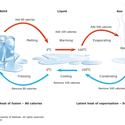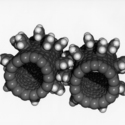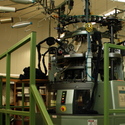Researchers and scientists are interested in the nanoscale1, because when many materials get down to these tiny sizes, they start to behave differently and novel2 properties emerge. Sometimes the material becomes explosive (for example, aluminium) or its melting point3 changes (for example, gold4) or a new property5 is revealed (for example, silver6 becomes antibacterial7 and an odour eater). These novel properties are mostly due to changes in size and scale and the physics ‘rules’ that govern materials at the nanoscale.
Changes in size and scale
Changes in size and scale are factors useful in helping to predict and describe a material’s behaviour. For example, the smaller something is, the larger its surface area8 (the amount of surface an object has) when compared to its volume9, so a nanoscale object, which is very small in at least one dimension, will have a vastly increased ratio of surface area to volume. The magnitude of this change depends on the size and shape of the nanoscale object. Consider the difference between a nanofibre, which is very thin and long, and a spherical nanoparticle10, which is very small and round.
Activity idea
The surface area to volume ratio depends on the size and shape of an object. If you would like to explore how this ratio changes for different shapes and sizes, here is an activity, Catalyst nanoparticle shapes, where students model different shapes using clay11 and calculate the surface area to volume ratios with the aim of trying to develop a more efficient shape.
This high surface area to volume ratio is a very important characteristic of nanoparticles when they are being used as catalysts. As chemical reactions take place at the surface of a chemical or a material, the greater the surface area for the same volume, the greater the reactivity12. So, for nanoparticles, maximising the available surface area available is important for maximising possible reactivity.
Changes in the physics ‘rules’
When a material reduces to the nanoscale, there’s a shift in the physics rules that govern and predict its behaviour. Nanofibres sit in between two sets of physics rules – those that govern macroscale and microscale objects (classical mechanics13) and those that govern atomic scale objects (quantum mechanics). This is illustrated in the scale ladder.
One well observed phenomenon at the nanoscale is that gravity14 becomes a markedly less significant force15, while van der Waals forces16 become incredibly strong. At the nanoscale, strong van der Waals forces make materials ‘sticky’, so a nanofibre can be very effective in attracting and trapping small particles because it’s ‘sticky’ and because it has a large surface area. This makes nanofibres excellent materials for use in filtration.
Electrospun collagen nanofibres for air-filtration
SetaTM air-filters have collagen17 nanofibres electrospun onto the surface of a potato starch18 based disc. Watch the video and listen to Iain Hosie explain the importance of van der Waals forces in nanofibre material being used for air filtration.
Future
Many novel properties are emerging as materials are being reduced from macroscale to nanoscale. This change in the properties of materials is leading to the creation of new and enhanced nanomaterials19. Nanoscale materials like nanoparticles and nanofibres have an exciting future in a wide range of high-tech applications.
Related content
The article Nanoscience explained provides an overiew of nanotechnology20, whilst Nanoscience – introduction provides useful links to our many nanoscience21 resources.
- nanoscale: Refers to dimensions below 100 nm. Also refers to the small size, often only a few nm, at which the properties of a substance are different to properties of bulk material.
- novel: New or unusual in an interesting way.
- melting point: The temperature at which a substance changes state from a solid to a liquid.
- gold: A transition metal in Group 11 of the periodic table – symbol Au, atomic number 79.
- property: A physical or chemical property is a physical or chemical state of a substance that can be measured. Any changes can be used to describe transformations between states.
- silver: A transition metal in Group 11 of the periodic table – symbol Ag, atomic number 47.
- antibacterial: A substance that can kill or prevent the growth of bacteria.
- surface area: The total area of an object or surface.
- volume: 1. The quantity of space occupied by a liquid, solid or gas. Common units used to display volume include cubic metres, litres, millilitres, tablespoons and teaspoons. (Volume can refer to a large quanity of something). 2. The degree of sound intensity or audibility; loudness.
- nanoparticle: A particle that has at least one dimension of 100 nm or less. Nanoparticles tend to have different properties to the same material at a larger size.
- clay: A naturally occurring fine-grained material formed from the chemical weathering of feldspar minerals found in rocks.
- reactive: The relative ability of an atom or molecule to undergo a chemical reaction with another atom, molecule or compound.
- mechanics: A field of physics that studies the action of forces on objects made of matter.
- gravity: The force attracting something towards the centre of Earth (or other large mass, like a moon or planet) – the reason that things fall to Earth.
- force: A push or a pull that causes an object to change its shape, direction and/or motion.
- van der Waals forces : Attraction forces between neighbouring molecules.
- collagen: Any of various tough, fibrous proteins found in bone, cartilage, skin, and other connective tissue. Collagens have great strength and their job is to form strong insoluble fibres that connect cells. Collagen is converted into gelatin when it is boiled.
- starch: A complex carbohydrate found chiefly in seeds, fruits, tubers, roots and stem pith of plants. Commonly found in foods, such as potatoes, wheat, rice and corn.
- nanomaterial: Are materials having particles or constituents of nanoscale dimensions.
- nanotechnology: Understanding and working with matter at the scale of atoms and molecules. 1 nanometre is a millionth of a millimetre.
- nanoscience: The study of atoms, molecules and objects whose size is on the nanometre scale (1–100 nanometres).







